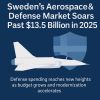Thales and Aura Aero join forces to develop connected avionics solutions
Aura Aero has signed a memorandum of understanding with Thales, a leader in onboard avionics systems, to jointly develop a next-generation connected avionics solution for electric and hybrid regional aircraft. Aura Aero, the project leader of the ERA (Electric Regional Aircraft), the very first European 19-seat regional aircraft with hybrid-electric propulsion, and Thales have therefore decided to work together to develop a global avionics suite specifically adapted to ERA.
This avionics suite includes a cockpit solution, a secure ground-to-board connectivity solution and a digital platform.
Thales is committed to the development of tactical and connected avionics solutions that revolutionise the flight experience by providing pilots with faster and more intuitive access to information for easier decision making.
Today, most regional aircraft are old generation fossil fuel consuming aircraft. In the face of current and future climate challenges, the powerful innovation movement launched by the aviation industry welcomes the arrival of new electric or hybrid aircraft.
Tomorrow's connected avionics is a strong contributor to reducing the environmental footprint, offering hybrid management and real-time trajectory optimisation. It will also make viable a new operating model, where regional aircraft, which can be operated by a single pilot, will perform point-to-point flights to secondary airports.
Key points
- First or second in electronics for civil satellites, mission systems and sensors for defence, air traffic management, data protection and SIM cards and smart payments, created in 2020;
- Revenues of €17bn from defence & security 54%, aerospace 28%, digital identity & security 19% and civil aerospace 7%;
- International presence, 24% in France, 29% in other European countries, 14% in Asia, 12% in North America and 9% in the Middle East;
- Business model based on 4 pillars: the strength of R&D, at 20% of sales, cross-business synergies derived from deep market knowledge, a broad base of digital assets and a global presence in 50+ countries;
- Capital locked in by 2 shareholders in concert, Dassault Aviation (24.63%) and the French State (25.68%), with Patrice Caine as Chairman and CEO of the 16-member board;
-Sound financial position with A- rated debt, significantly reduced to €894m at the end of June against €7.6bn equity.
Challenges
- Strategy to refocus on aerospace, defence & security and digital identity & security;
- Innovation strategy supported by R&D close to 20%:
- Global ecosystem comprising 1/3 of the workforce, with a portfolio of over 23,000 patents, 6 hubs, 3 digital factories and 50 academic partnerships;
- focus on 5 digital expertises: connectivity, bid data, cybersecurity and artificial intelligence, via the AI@Centech programme and the TrUE AI quantum approach;
- Low-carbon environmental strategy:
- 25% reduction in direct CO2 emissions in 2023, 50% in 2030 (vs 2018) and net zero target in 2040,
- 100% of products and services eco-designed by 2023,
- launch of green loans,
- 4 priority areas: environmental management, flight optimisation, air traffic management, training and signalling;
- Acceleration of activities, contract wins and investments in defence and security (2/3 of estimated profits) and aerospace (15%);
- Acquisitions of Excellium and S21sec (security division) and AAC (sonar);
- Visibility with a record order book boosted by the start of Rafale sales to the United Arab Emirates and, more globally, by Defence & Security needs.
Challenges
- Tensions in supply chains, especially semiconductors and inflation: resilience of supply chains, ramping up of recruitment and transfer of procurement costs to customers;
- Spin-offs from advances in avionics and biometrics as air traffic picks up, followed by R&D investments in quantum sensors, cloud security and IoT data processing;
Pace of aerospace orders below that of the group;
- After a 41% jump in order intake and 9.6% increase in revenues to the end of September 2022, 2022 objectives confirmed: revenues up by close to 5.5% and operating margin of 10.8 to 11.1%.
- Interim dividend of €0.70 paid in December and share buybacks.
The end of a duopoly?
For several decades, the American Boeing and the European Airbus have shared 99% of the world market for airliners with more than 110 seats. This market is worth more than 100 billion dollars per year. Nevertheless, this duopoly appears to be undermined in 2022 for several reasons. Firstly, for the first time, two medium-haul single-aisle aircraft, the C919 from China's Comac and the MC-21 from Russia's Irkut, are about to enter service. Added to this is the crisis of the Boeing 737 MAX. With deliveries of this aircraft halted between 2019 and 2021, the production balance has been broken. In 2021 Boeing has posted 340 deliveries, with Airbus remaining well ahead with 611.




